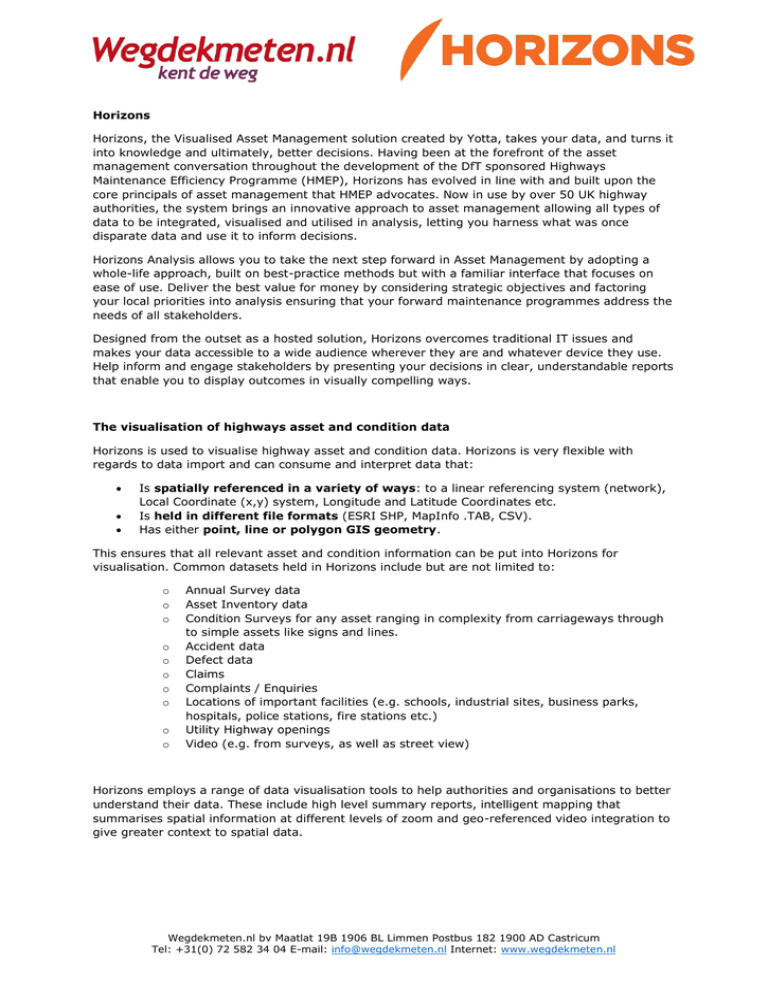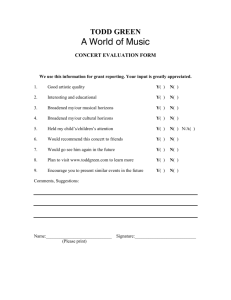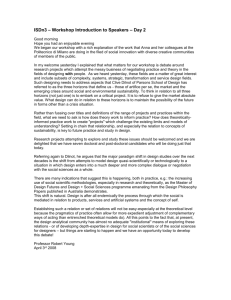Horizons Horizons, the Visualised Asset
advertisement

Horizons Horizons, the Visualised Asset Management solution created by Yotta, takes your data, and turns it into knowledge and ultimately, better decisions. Having been at the forefront of the asset management conversation throughout the development of the DfT sponsored Highways Maintenance Efficiency Programme (HMEP), Horizons has evolved in line with and built upon the core principals of asset management that HMEP advocates. Now in use by over 50 UK highway authorities, the system brings an innovative approach to asset management allowing all types of data to be integrated, visualised and utilised in analysis, letting you harness what was once disparate data and use it to inform decisions. Horizons Analysis allows you to take the next step forward in Asset Management by adopting a whole-life approach, built on best-practice methods but with a familiar interface that focuses on ease of use. Deliver the best value for money by considering strategic objectives and factoring your local priorities into analysis ensuring that your forward maintenance programmes address the needs of all stakeholders. Designed from the outset as a hosted solution, Horizons overcomes traditional IT issues and makes your data accessible to a wide audience wherever they are and whatever device they use. Help inform and engage stakeholders by presenting your decisions in clear, understandable reports that enable you to display outcomes in visually compelling ways. The visualisation of highways asset and condition data Horizons is used to visualise highway asset and condition data. Horizons is very flexible with regards to data import and can consume and interpret data that: Is spatially referenced in a variety of ways: to a linear referencing system (network), Local Coordinate (x,y) system, Longitude and Latitude Coordinates etc. Is held in different file formats (ESRI SHP, MapInfo .TAB, CSV). Has either point, line or polygon GIS geometry. This ensures that all relevant asset and condition information can be put into Horizons for visualisation. Common datasets held in Horizons include but are not limited to: o o o o o o o o o o Annual Survey data Asset Inventory data Condition Surveys for any asset ranging in complexity from carriageways through to simple assets like signs and lines. Accident data Defect data Claims Complaints / Enquiries Locations of important facilities (e.g. schools, industrial sites, business parks, hospitals, police stations, fire stations etc.) Utility Highway openings Video (e.g. from surveys, as well as street view) Horizons employs a range of data visualisation tools to help authorities and organisations to better understand their data. These include high level summary reports, intelligent mapping that summarises spatial information at different levels of zoom and geo-referenced video integration to give greater context to spatial data. Wegdekmeten.nl bv Maatlat 19B 1906 BL Limmen Postbus 182 1900 AD Castricum Tel: +31(0) 72 582 34 04 E-mail: info@wegdekmeten.nl Internet: www.wegdekmeten.nl Visualising data at different scales All data in Horizons can be viewed at different levels of detail from the overall network level (as seen in the image below), through to the individual ward level, street level and even subsection level. High level Red Amber Green (RAG) mapping of condition as well as a doughnut chart displaying the percentage of the network (in red) considered to require planned maintenance. This summary report shows the breakdown of defects over an 18 month period within a particular ward on an authority’s network. Potholes make up 48.09% to the total number. Wegdekmeten.nl bv Maatlat 19B 1906 BL Limmen Postbus 182 1900 AD Castricum Tel: +31(0) 72 582 34 04 E-mail: info@wegdekmeten.nl Internet: www.wegdekmeten.nl Mapping Visualisations of data When looking at complex data at a detailed level, Horizons employs many unique visualisation techniques and tools to help you to quickly interpret information. Example of Summary Red Amber Green SCANNER condition mapping (bubble size and colour indicates severity of poor condition). Graphing at the bottom shows far more condition detail, with individual charateristics of the road plotted including rut depth, texture depth, cracking and ride quality. Video further helps you understand your asset condition. Wegdekmeten.nl bv Maatlat 19B 1906 BL Limmen Postbus 182 1900 AD Castricum Tel: +31(0) 72 582 34 04 E-mail: info@wegdekmeten.nl Internet: www.wegdekmeten.nl Example of Street Lighting Consequence data (TR22), displaying a score highlighting the potential magnitude of the consequence for failure of different columns across the authority. The ‘hotspot mapping’ viewed above can be applied to any numeric datasets held in Horizons helping you to visualise where there may be issues with your assets. Common examples of hotspot mapping applications include: IRI hotspots Individual survey parameter hotspots (e.g. Rutting, Cracking, Ride Quality etc.) Accident hotspots Reactive maintenance spend hotspots Asset age Video Imagery and Data Visualisation Horizons allows spatial data to be projected into high resolution video imagery to give it further context and also allows for accurate measurements to be made. Here is an example of SCANNER Red Amber Green data projected into a SCANNER video image and a lane width measurement of 4.4m being made. Wegdekmeten.nl bv Maatlat 19B 1906 BL Limmen Postbus 182 1900 AD Castricum Tel: +31(0) 72 582 34 04 E-mail: info@wegdekmeten.nl Internet: www.wegdekmeten.nl Here is an example of a Street Lighting condition data projected into imagery in Horizons. The data and the image both suggest the column is in a poor condition. Horizons also allows you to view and measure from pavement imagery if available. This is excellent for identifying surface defects like cracking and fretting. Wegdekmeten.nl bv Maatlat 19B 1906 BL Limmen Postbus 182 1900 AD Castricum Tel: +31(0) 72 582 34 04 E-mail: info@wegdekmeten.nl Internet: www.wegdekmeten.nl Horizons also produces false colour visualisations to help engineers to interpret asset condition. This image is at the same location as the pavement image seen above but this time shown as a surface elevation profile. It is clear that the surface is markedly uneven from this image. Other visualisations include texture depth, crack detection, ride quality & rut detection. Wegdekmeten.nl bv Maatlat 19B 1906 BL Limmen Postbus 182 1900 AD Castricum Tel: +31(0) 72 582 34 04 E-mail: info@wegdekmeten.nl Internet: www.wegdekmeten.nl Checking annual progress improvements and declining conditions overtime Horizons can display multiple years of condition/performance data and video. Horizons also links directly to Google Street View allowing you to review the different years of imagery captured by the Google on any part of your network as well. This allows you to easily visually appraise how an asset or group of assets have performed overtime and understand the efficacy of treatment regimes A Road SCANNER RCI data recorded in the 2008/2009 financial year. Note that areas of the network appear to be in poor condition. Wegdekmeten.nl bv Maatlat 19B 1906 BL Limmen Postbus 182 1900 AD Castricum Tel: +31(0) 72 582 34 04 E-mail: info@wegdekmeten.nl Internet: www.wegdekmeten.nl Fig. 31 – A Road SCANNER RCI data recorded in the 2015/2016 financial year. Note that the network appears to have generally improved overtime (compared to Fig 30), although condition in the bottom right of the map has actually worsened. Fig. 32 – If information is detailed enough, it can be graphed against a section of the carriageway to show change through time. In the example above, we see a comparison of Rut depth between 2008/09 and 2014/15. Rutting has improved due to maintenance activity in the intervening years. Wegdekmeten.nl bv Maatlat 19B 1906 BL Limmen Postbus 182 1900 AD Castricum Tel: +31(0) 72 582 34 04 E-mail: info@wegdekmeten.nl Internet: www.wegdekmeten.nl Fig. 33 – Snapshot of Non-UKPMS condition information. This shows an 18 month snapshot of carriageway defect spend information. Making Asset Management Decisions with your data Horizons through its Analysis module can be used to support decision making and asset management planning over the short, medium and long term. It enables you to define ‘decision’ rulesets against data held within your system to identify locations requiring some sort of intervention including but not limited to: Potential Maintenance on a range of assets Carriageway Site Investigation (Related to wet-skidding issues) Carriageway and Footway Utility investigation (Related to potentially failing reinstatements) Adaptive lighting (dimming of street lighting) programmes based on multi-criteria analysis Evaluating Gully condition and Silt depths to target maintenance and refine emptying regimes. The analytical process through which decision support is delivered explained in this answer will focus on identifying potential carriageway maintenance requirements. Other examples of decision support including those referred to above follow a similar process. Maintenance analysis in Horizons follows a three stage process: 1. Identifying a Backlog of Schemes (Identification of needs) 2. Multi-criteria Analysis of schemes (Prioritisation and Value Management of Schemes) 3. What-if scenario projection modelling and multi-year works programmes Wegdekmeten.nl bv Maatlat 19B 1906 BL Limmen Postbus 182 1900 AD Castricum Tel: +31(0) 72 582 34 04 E-mail: info@wegdekmeten.nl Internet: www.wegdekmeten.nl 1. Identifying Schemes Categorising Assets Before the process of modelling occurs, Horizons allows you to categorise your assets into homogenous groups and subgroups. This is important as within the modelling process, these groups of assets will be deemed to behave the same way in terms of how they deteriorate, the types of remedial treatments that can be applied to them, and the circumstances within which those treatments will be applied. Assets can be categorised by whatever information you hold against them. In the case of carriageways, the default grouping is by road class and urban rural split which is held against the UPKMS network. This however does not necessarily generate groupings with broadly homogenous assets. Authorities with more information available have grouped their assets in other ways including combinations of: Road Hierarchy information Surface material type Annual Average Daily flows Construction Combinations of the above groupings are likely to yield better modelling results as empirical deterioration profiles generated by Horizons as well as maintenance intervention types and thresholds are likely to be more representative of the of all of the assets within each group. Asset Condition Data Horizons can use a range of condition datasets to identify schemes such as: Annual survey condition data (Visual and machine based) Rates of reactive spend Asset age Schemes identified outside of the modelling process etc. Above is an example of one of the many parameters that can be used to identify maintenance in Horizons. In this case we can see hotspot mapping of rut depth measured from a SCANNER survey Wegdekmeten.nl bv Maatlat 19B 1906 BL Limmen Postbus 182 1900 AD Castricum Tel: +31(0) 72 582 34 04 E-mail: info@wegdekmeten.nl Internet: www.wegdekmeten.nl Deteriorating Condition Data In order to create analytical models to understand future maintenance needs, the first thing you need to be able to do is define how the asset will deteriorate if no remedial action is taken. Horizons allows you to apply the following types of deterioration to your data: Deterioration History (empirically built from the data) Quadratic Linear Useful Life Custom A deterioration delay (Tini) can also be defined: Empirical Deterioration Curve for Rutting on Rural A-Roads based on historic SCANNER data The deterioration History method, where deterioration curves are built empirically from analysis of condition change over time defined by multiple years of condition data, is particularly useful in producing accurate and locally relevant projection models for local authorities. This is because a high proportion of local authority roads are evolved (not designed) making the task of predicting deterioration harder for engineers due to the number of ‘unknowns’ that can affect condition change. Another advantage of the deterioration modelling provided by Horizons is that it can address the issue of having condition data across your network that was captured in different years. Survey data, can often be staggered over 2 - 4 years (depending on survey type and road class) to gain full network coverage. Horizons offers the facility to deteriorate all condition data to a common date before projecting into the future. This ensures fairness when comparing maintenance needs to arrive at a programme of works. Wegdekmeten.nl bv Maatlat 19B 1906 BL Limmen Postbus 182 1900 AD Castricum Tel: +31(0) 72 582 34 04 E-mail: info@wegdekmeten.nl Internet: www.wegdekmeten.nl Finally, the deterioration rates in Horizons are completely configurable through the quadratic, linear, useful life and custom deterioration mechanisms meaning that scenarios where the asset is subjected to severe, moderate and mild exposure conditions can be evaluated. Treatments Once you have defined how your asset will deteriorate through time, the next thing to do is define the remedial treatments you will do to counter that deterioration. You can define the specific treatments carried out locally on your network with the flexible treatment editor: Flexible Treatment Editor allowing you to define all the characteristics of the types of maintenance interventions made locally on your assets. Wegdekmeten.nl bv Maatlat 19B 1906 BL Limmen Postbus 182 1900 AD Castricum Tel: +31(0) 72 582 34 04 E-mail: info@wegdekmeten.nl Internet: www.wegdekmeten.nl Scheme Identification Next you need to define the circumstances by which your treatments will be applied (i.e. what prerequisite conditions would you expect to see for maintenance to be identified in the model). Horizons can identify maintenance using a combination of data. Firstly you define condition Intervention levels (triggers) required for treatments to be identified e.g. ride quality (IRI), rut depth, % ravelling, rates of reactive spend, asset age etc. Two intervention levels (triggers) applied to the rutting parameter for maintenance identification – 11mm and 24mm Next, the combination of condition triggers required for each treatment is defined. Wegdekmeten.nl bv Maatlat 19B 1906 BL Limmen Postbus 182 1900 AD Castricum Tel: +31(0) 72 582 34 04 E-mail: info@wegdekmeten.nl Internet: www.wegdekmeten.nl In the example above, two trigger rules are used for a 100mm Inlay. The first requires both poor ride quality and rutting from a SCANNER (machine based) survey to be present and the second requires poor residual life from a deflectograph survey to be present. Estimated Treatment lives are automatically calculated based on: Treatment intervention levels Condition deterioration rates Treatment effects on condition The above 100mm Inlay has an Estimated Treatment life of 21 years after its applied based on how well it improves condition, how condition deteriorates through time and defined treatment intervention levels Wegdekmeten.nl bv Maatlat 19B 1906 BL Limmen Postbus 182 1900 AD Castricum Tel: +31(0) 72 582 34 04 E-mail: info@wegdekmeten.nl Internet: www.wegdekmeten.nl This assists in the validation of your maintenance rules, ensuring they match engineering expectations. Horizons analyses your maintenance rules over user-defined subsection lengths (e.g. 10m, 20, 50m, 100m etc. of carriageway). For each subsection, it identifies the highest hierarchy treatment that it can apply. It then merges treatment subsections together into schemes based on the min/max scheme lengths and merge rules you defined for each treatment type. Backlogs of maintenance (Identification of Needs) Once all rules are calibrated, Horizons applies them to all of the relevant condition data across your network and calculates the maintenance backlog (termed a Treatment Set). Being cloudbased, Horizons can draw on vast processing resources to ensure results are derived quickly. This speed enables iterative refinement of maintenance rules, ensuring schemes are being identified where engineers would expect them. These can be reviewed spatially in Horizons Explorer, with high level summary reports available as well as a downloadable backlog treatment list (in csv format). A backlog of Schemes mapped in the Horizons Explorer module Wegdekmeten.nl bv Maatlat 19B 1906 BL Limmen Postbus 182 1900 AD Castricum Tel: +31(0) 72 582 34 04 E-mail: info@wegdekmeten.nl Internet: www.wegdekmeten.nl An extract from an interactive maintenance backlog report in Horizons providing the overall backlog figure and breaking that figure down by treatment type. Wegdekmeten.nl bv Maatlat 19B 1906 BL Limmen Postbus 182 1900 AD Castricum Tel: +31(0) 72 582 34 04 E-mail: info@wegdekmeten.nl Internet: www.wegdekmeten.nl 2. Multi-Criteria Analysis (Prioritisation and Value Management) Once the backlog of maintenance has been defined, you have both mapping and reporting outputs showing scheme locations and required treatments to bring the network condition up to a fully serviceable level. From this foundation, Horizons then allows you to calculate when these treatments should be done. The first step available in this process is to prioritise your maintenance by locally important priorities. Often these prioritisations reflect stakeholder and organisational requirements. Any spatial layer (point, line or polygon) held in Horizons can serve as a prioritisation layer to add weight to co-located schemes. Spatially referenced information can be imported into Horizons either manually or automatically via the Horizons Application Programming Interface (API). The spatial reference can be against: The linear referencing system (network) Spatial Coordinates (Eastings & Northings / Longitude & Latitude) ESRI SHP, MapInfo .TAB and .CSV file formats are accepted for import. Horizons is very flexible with regards to data import. Files can range from those that are small and simple (e.g. a point layer only identifying locations of complaints) to those that are large and complex (e.g. a layer accident rates, a Lighting column inventory dataset, or a polygon layer identifying areas of flood risk). In addition, the import time for most files takes only minutes. This flexibility to import spatial data into Horizons means that comprehensive Multi-Criteria Analysis based on your priorities can be applied to the maintenance programme. This is achieved through the creation of Priority Weighting Sets. Users can create several priority weighting sets to explore impacts of varying priorities on maintenance selection as seen in the image below. A dropdown list of various priority weighting sets available to prioritise maintenance schemes Wegdekmeten.nl bv Maatlat 19B 1906 BL Limmen Postbus 182 1900 AD Castricum Tel: +31(0) 72 582 34 04 E-mail: info@wegdekmeten.nl Internet: www.wegdekmeten.nl There are two methods of defining priorities within a priority weighting set. The first involves defining a relative importance to each priority when compared to all other priorities. Horizons can then automatically calculate priority weightings from this. Defining a relative importance to each priority The second method involves the setting of independent weightings for each priority. Applying independent weightings to each priority Priorities that occur near a scheme add their weighting to the scheme’s score advancing it up the priority list. Wegdekmeten.nl bv Maatlat 19B 1906 BL Limmen Postbus 182 1900 AD Castricum Tel: +31(0) 72 582 34 04 E-mail: info@wegdekmeten.nl Internet: www.wegdekmeten.nl An Inlay has been identified between the roundabouts. The presence of Accidents and Claims along the same length of road will add weighting to the Inlay score. Wegdekmeten.nl bv Maatlat 19B 1906 BL Limmen Postbus 182 1900 AD Castricum Tel: +31(0) 72 582 34 04 E-mail: info@wegdekmeten.nl Internet: www.wegdekmeten.nl 3. What-if scenario projection modelling Horizons allows for multiple multi-year projection modelling scenarios of up to 30 years to be evaluated, facilitating greater understanding of the relationship between budgets, maintenance strategies and asset performance. For each year of the projection scenario, Horizons will: Deteriorate all Condition data against predefined deterioration rates Select treatments based on treatment rules, maintenance strategies, priority weightings and available budgets Improve condition where treatments have been applied From this process, Horizons is able to: Generate provisional Multi-year maintenance programmes mapped spatially and provided in a prioritised list. Track condition change of each individual condition parameter through time across the network Report how the average and maximum condition values for each condition parameter changes through time. Calculate the maintenance backlog value for each year the model is run. Insights gained from such modelling have been used to calibrate achievable service levels and performance targets, as well as identifying any gaps between current and predicted performance based on current spend and aspirational targets. These modelling capabilities help to ensure organisational alignment between publically visible Asset Management Policy and Strategy documents and the actual delivery of Asset Management on the ground. Highly visual reports are also generated to help to inform non-technical decision makers about the financial and performance related realities of managing your assets. Wegdekmeten.nl bv Maatlat 19B 1906 BL Limmen Postbus 182 1900 AD Castricum Tel: +31(0) 72 582 34 04 E-mail: info@wegdekmeten.nl Internet: www.wegdekmeten.nl Model and Evaluate Different Budget Scenarios: Horizons allows you define and model any number of different investment profiles to assess their impact on asset performance for a given maintenance strategy. The above screenshots show examples of setting up different investment profiles for use in modelling in Horizons. These budgets can be applied across the network, to sub-networks, or to individual asset groups like principal roads. Wegdekmeten.nl bv Maatlat 19B 1906 BL Limmen Postbus 182 1900 AD Castricum Tel: +31(0) 72 582 34 04 E-mail: info@wegdekmeten.nl Internet: www.wegdekmeten.nl Modelling can identify the impacts of spend on performance measures including: The Backlog maintenance figure Condition Summary Scores (UK only currently, though others could be developed) Maximum condition parameter values like ride quality, rutting, cracking, IRI. Mean condition parameter values like ride quality, rutting, cracking, IRI. The above UK condition summary reporting extract shows the impact of different spend levels on the performance of B & C Roads. Wegdekmeten.nl bv Maatlat 19B 1906 BL Limmen Postbus 182 1900 AD Castricum Tel: +31(0) 72 582 34 04 E-mail: info@wegdekmeten.nl Internet: www.wegdekmeten.nl Model and Evaluate Maintenance Strategy Performance: The projection modelling in Horizons allows you to compare the performance of different maintenance strategies from a conventional Worst First approach, to asset sweating, to more preventative or structurally focused programmes. The above reporting extract shows average carriageway rutting over 15 years for three different maintenance scenarios. Model and Evaluate Costs of Maintenance Strategies: Costs over the projection period for each scenario are calculated along with costs factored by Net Present Value. This enables assessment of the investment required to achieve performance goals which can range from maintaining a steady state in overall network condition to focusing on particular aspects of the networks performance like achieving a particular safety target related to texture depth. Wegdekmeten.nl bv Maatlat 19B 1906 BL Limmen Postbus 182 1900 AD Castricum Tel: +31(0) 72 582 34 04 E-mail: info@wegdekmeten.nl Internet: www.wegdekmeten.nl Three 5 year scenarios are shown in the report extract above. Scenario 3 requires texture to be maintained above 0.3mm. However, it is clear from the modelling that there is a gap between the costs to achieve this performance target and the budgets available. Provisional Multi-Year Works Programmes: Works Programmes, exportable as .CSV files, are generated from the projection modelling described above. Depending on the specific scenario run, schemes are selected for each year of the programme: To meet performance targets, If they are critical (i.e. further delay will result in a more expensive treatment), According to their Benefit Cost Ratio (BCR) score. If performance targets have been set, schemes will be selected until the target is met (or the model has got as close to achieving the target as is possible) and annual spend may exceed budget. If no targets have been set, then schemes will be selected each year within the available budget. Wegdekmeten.nl bv Maatlat 19B 1906 BL Limmen Postbus 182 1900 AD Castricum Tel: +31(0) 72 582 34 04 E-mail: info@wegdekmeten.nl Internet: www.wegdekmeten.nl Below is an example of a provisional multi-year works programme from Horizons: A sample of a provisional multi-year works programme. Scheme information includes Budget Year, Treatment Type, location, BCR, costs, and scheme ranking. These lists can be exported for the whole network or individual areas Wegdekmeten.nl bv Maatlat 19B 1906 BL Limmen Postbus 182 1900 AD Castricum Tel: +31(0) 72 582 34 04 E-mail: info@wegdekmeten.nl Internet: www.wegdekmeten.nl Individual Scheme Plan reports can also be generated in Horizons, and shared via the ‘Deep linking’ function, which creates a unique web address that can be used to directly access the report in Horizons (rather than having to navigate to it) and also printed or downloaded as a PDF. Wegdekmeten.nl bv Maatlat 19B 1906 BL Limmen Postbus 182 1900 AD Castricum Tel: +31(0) 72 582 34 04 E-mail: info@wegdekmeten.nl Internet: www.wegdekmeten.nl Individual scheme plan with all associated attributes including treatment type, cost, length etc. and a map location of the scheme Lifecycle planning and Whole Life Costing When modelling economic scenarios, Horizons incorporates the principles of lifecycle planning to optimise scheme selection each year. Horizons looks at the whole life cost until the next required treatment intervention on an asset based on the likely deterioration in condition, the defined treatment intervention thresholds and the efficacy of each treatment in improving asset condition. Horizons employs the following concepts to optimise maintenance timing and treatment selection: Timing Interventions (Asset Sweating) Benefit Cost Ratio analysis of competing treatment options Timing Interventions ensures that the maximum life of the asset is realised before a treatment that can be applied, is applied. The benefits of this process are illustrated in the diagrams below: Asset deterioration overtime shown by the black lines (and potential deterioration by the grey lines), with treatment interventions defined by the green points. As the asset follows the potential deterioration profile, treatments become more expensive. In the Figure 53 above, treatments are being applied in the model as soon as the conditions dictate that a treatment could be applied. As a result, the asset is treated twice over the projected time period. In the Figure 54 below, the interventions have been timed such that the treatment is only applied at the point where further inaction would lead to the requirement of a more expensive treatment. By waiting before applying the treatment, the asset has only required one intervention over the same time period. Asset deterioration overtime shown by the black lines (and potential deterioration by the grey lines), with treatment interventions defined by the green points. As the asset follows the potential deterioration profile, treatments become more expensive. Notice that with sound timing of interventions, fewer treatments are required overtime. Wegdekmeten.nl bv Maatlat 19B 1906 BL Limmen Postbus 182 1900 AD Castricum Tel: +31(0) 72 582 34 04 E-mail: info@wegdekmeten.nl Internet: www.wegdekmeten.nl Benefit Cost ratio analysis of the optimal treatment intervention is calculated by Horizons analysing the next lifecycle phase of an asset from the point at which a treatment is required. Horizons will start with the least expensive treatment that will repair the current condition and calculate: a) The Benefit in terms of how much the treatment will improve the asset condition (i.e. rutting, cracking, ride quality, texture etc.) b) The Benefit in terms of how long the asset will last until the next intervention is required. c) The treatment cost From this information, Horizons can calculate a BCR Score for the scheme. Horizons then considers the same benefits and costs of deeper treatments and identifies BCR scores for those as well. The treatment with the highest BCR score is then selected for that particular site. Each scheme in a multi-year works programme is given a BCR score and additionally, Multi-year site reports can be generated at any given location on the network showing when and what the next maintenance intervention in the assets lifecycle is predicted to be. The Horizons model is showing that the section of carriageway highlighted in the map, based on the latest condition data and probable deterioration rates will require a Micro-Asphalt treatment in the 2024/25 Financial Year. Additionally, asset lifecycles are dynamically updated in Horizons as new data becomes available. For instance, lifecycles may alter if a treatment could not be applied at an optimum time due to funding restrictions, or if the asset deteriorates more aggressively due to a severe winter. Wegdekmeten.nl bv Maatlat 19B 1906 BL Limmen Postbus 182 1900 AD Castricum Tel: +31(0) 72 582 34 04 E-mail: info@wegdekmeten.nl Internet: www.wegdekmeten.nl



